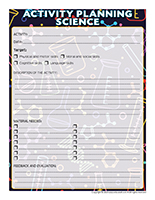
Interactive planning-Science
(Open interactive planning-Science) Enter your planned activities directly in the document, print it, and add it to your activity planning binder.
CIRCLE TIME
Children sit in a circle. Ask a child to whisper a word into the ear of the child sitting to his right. This child then whispers the word into the ear of the child sitting to his right, and so on until the word has travelled around the circle. Ask the last child to say the word out loud. Play this telephone game as long as you want. Explain how the telephone is an exceptional scientific invention!
A treasure hunt to discover the theme
(Open educa-decorate-Science) Print and laminate. Set the illustrations on items throughout your daycare. Encourage children to collect them. Name the items as they hand them to you. Invite children to guess the theme.
3D Circle time-Science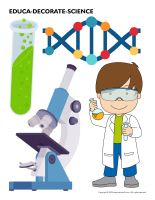
Set a wide range of items related to the theme (magnifying glass, microscope, telescope, thermometer, test tube, safety glasses, funnel, scale, spatula, beaker, etc.) in the center of your circle time area. Invite children to observe the items and guess the theme. Encourage them to try to name the different objects and explore what they are used for with your group.
AREA SETUP
Thematic poster-Science
(Open thematic poster-Science) Print and display within your daycare to introduce the theme.
Stickers-Science
(Open stickers-Science) Print the illustrations on adhesive paper and use them to create original stickers.
Educa-theme-Science
(Open educa-theme-Science) Print and laminate the elements representing the theme. Use them to present the theme to your group while decorating your daycare.
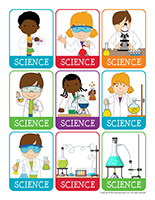
Educa-decorate-Science
(Open educa-decorate-Science) Print, laminate, and cut out. Decorate your walls with the illustrations or hang some from the ceiling to set the mood for the theme.
Set up a science corner which can be enjoyed throughout the theme. If you already have a permanent science corner within your daycare, change its setup to renew children's interest. Display a poster of Globule (Open Globule). He is the perfect character to introduce children to their new science corner. Display other science-related posters on the wall. You may also hang a few from the ceiling. To complete the corner, prepare a thematic bin complete with a variety of items that will encourage scientific play and discovery. You may even hang a few white shirts or smocks on hooks. Children will love wearing them and pretending they are little scientists.
Thematic bin: magnifying glass, safety glasses, rubber gloves, eyedropper, measuring cups, funnel, sea shells, rocks, magnets and paper clips, colored rice, tongs, cotton balls, beans, mirror, small lights, small notebook, crayons, pebbles, cones, balls, dried leaves, seeds, buttons, empty bottles, flashlights, plants, etc.
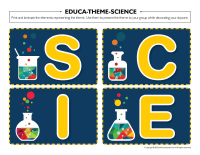
VARIOUS WORKSHOPS
Have fun with these wonderful workshop ideas provided by Caroline Allard.
Construction/building blocks (shape and density):
- This theme is perfect for exploring the density of various materials along with their shape. Use hard blocks (wooden) and soft blocks (foam) to make comparisons regarding textures and weight.
- Various shapes of blocks and balls (if you do not have round blocks) to compare and make all kinds of constructions.
- Various means of transportation (4 wheels, 2 wheels, no wheels, with wings, without wings) to encourage children to make comparisons.
- Empty paper towel rolls can be used to make tunnels that go up and down (objects move faster when they go down!)
Arts & crafts (colors):
- Introduce children to color combinations.
- Blue, red, and yellow poster paint (primary colours) can be mixed together to make green, purple, orange, and brown (when all the colours are mixed together).
- Different colors of tissue paper and white glue can be used to layer colors to see new colors appear.
- Transparent colorful paper (cellophane) is also great for layering. It can also be used to see through and appreciate colours. Why not make glasses like the ones used to watch 3D movies?
Role play:
- Explore careers and professions related to science such as chemist, biologist, scientist, etc.
- White shirts or smocks with glasses.
- Measuring cups, eyedroppers, bowls, measuring spoons, scale, toy microscope, funnels, straws, containers in different sizes, etc.
- If you are up to it, provide real ingredients and let children invent their own recipes (flour, cornstarch, Jell-O powder, soapy water...).
Manipulation (magnets):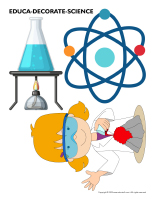
- Magnets impress children. They will have fun playing with them in a variety of ways!
- Magnetic bingo chips.
- Magnets with a variety of objects to explore which items are attracted to them.
- Various magnetic shapes (birds, characters, etc.) and a metal cookie sheet. Let children create stories and scenes.
Pre-reading (observation):
- Science books.
- Visit your local library. In the 9-12 year old section, you will find books that illustrate the steps involved in a variety of scientific experiments.
- Magnetic books, children love creating stories.
Music/Motor skills:
- Balloons that can be inflated (have several on hand) and then rubbed on children's hair to create static. To the sound of music, throw them in the air and watch them stick to the ceiling.
- A feather or a tissue can be thrown up in the air. Encourage children to sit down before they touch the ground.
- Teach children to juggle...to explore gravity!
Sensory bins (sense of touch):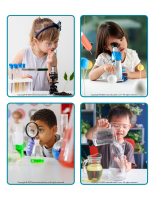
- Rice, sand, pasta, or water bins are all interesting for this theme. They all have different properties.
- Water table with objects that float and objects that sink. Certain objects sink slowly while others sink instantly. Have children make predictions!
Science (experiments):
- Guide children through various experiments to avoid messes.
- Experiment with hot and cold.
- Dye rice or pasta.
- Milk and food coloring.
- Pepper is afraid of soap!
- Volcanoes always fascinate children!
- Let your imagination guide you...you can demonstrate experiments or let children manipulate the material.
ACTIVITY SHEETS
Activity sheets are suggested for each theme. Print and follow instructions. (Open activity sheets-Science)
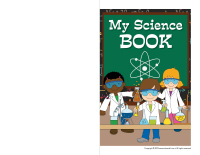
PICTURE GAME
The pictures may be used as a memory game or to spark a conversation with your group. Use them to decorate your daycare or a thematic corner. (Open picture game-Science) Print, laminate, and store in a "Ziploc" bag or in your thematic bin.
My science book
(Open science book) Print for each child. Invite them to draw the various steps involved in their science experiments. Practice “reading” their science book with them.
Sequential story-Science
(Open sequential story-Science) Print, laminate, and cut the illustrations. Have children arrange them in the correct order to recreate the story. With younger children, you may remove 1 or more cards.
WORD FLASHCARDS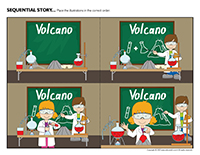
The flashcards may be used to spark a conversation with your group, in your reading and writing area, or to identify your thematic bins. (Open word flashcards-Science) magnifying glass, microscope, telescope, thermometer, test tube, tongs, safety glasses, funnel, scale, flask, burner, scientist
ACTIVITIES
Modeling dough activity placemats-Science
(Open modeling dough activity placemats-Science) Print and laminate. Let children pick a placemat and provide modeling dough. Encourage them to use the dough to fill or reproduce the shapes that are on their placemat.
Playing cards-Science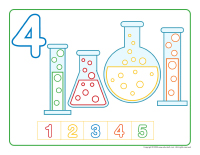
(Open playing cards-Science) Print and laminate the playing cards. Give each child the same number of cards. Children take turns hiding the cards in your daycare. When they are done, the hunt begins. Children try to find as many cards as possible.
Playing cards-Science
(Open playing cards-Science) Print and laminate the playing cards and hide them throughout your daycare or yard. Divide your group into two teams. When you give the signal, children race to collect as many cards as possible. Set a timer.
Lotto game-Science
(Open lotto game-Science) Print a playing card for each child. Print and laminate the small cards. Cut them out and arrange them in a pile. Children take turns picking a card. They check their card to see if the item is on it. If it is, they set it on their playing card. Otherwise, they set the card on the discard pile and their turn is over.
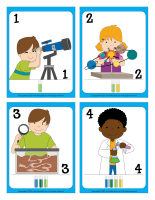
Educ-clothespins-Science
(Open educ-clothespins-Science) Print and laminate. Children must identify the correct picture using a clothespin.
Magnetic fishing game-Science
(Open magnetic fishing game-Science) Print and laminate the items to create a fishing game. Attach a paperclip to each item. Use a toy fishing rod or make your own by attaching a string to one end of a wooden stick and pressing a magnet on the hanging end.
Beads and pipe cleaners-Science
(Open beads and pipe cleaners-Science) Print the cards. Provide necklace beads and pipe cleaners corresponding to the colors seen on the cards. Children thread the beads onto the pipe cleaners and form circles by twisting the ends together.
Educ-pattern-Science
(Open educ-pattern-Science) Print and laminate the game. Children must determine the correct order and complete each pattern by setting the cards in the appropriate squares using Velcro or adhesive putty.
Sticky balloons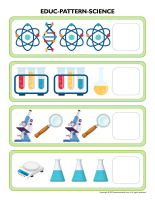
Give each child an inflated balloon. Have them rub their balloon on their hair and then on a wall to explore static electricity.
The parachute
Use various parachute games to explore the concept of gravity. You will find a multitude of games here: The parachute-A complete activity - Extra activities - Educatall.
Color combinations
Explore different color combinations using finger paints. Simply set 2 different colors on a piece of paper, name them, and encourage children to use their fingers to mix them together. Name the new color that results from mixing the finger paints and repeat with 2 new colors.
Reflection in the mirror
Invite children to examine their reflection in mirrors of different sizes. Place the mirrors at various distances. Make funny faces. Discuss.
Pouring water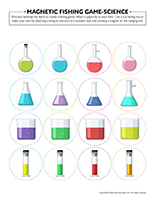
Fill several containers with water. Provide exploration material: small spoons, measuring cups, funnels... Children can observe how water pours differently, depending on the container. Variation: Notice how certain objects float while other objects sink.
Seeing with your hands
Deposit several objects in a paper bag or in a box. Use objects children are familiar with. They should have different sizes and textures. Have children close their eyes or blindfold them. Invite children to grasp an object using their hands and feel it to try to guess what it is.
Magnet game
Deposit a variety of objects on the table (nails, paper clips, coins, rubber bands, aluminum, crayons, blocks, lipstick, etc.). Place a magnet near each object, one at a time. Sort the objects. Place the ones attracted to the magnet in one container and the ones which are not attracted to the magnet in another container. Help children understand that metals are attracted to magnets.
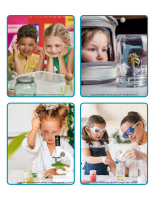
Science story
(Open story and memory game-Science) Print, cut out, and laminate the illustrations. Place them face down on a table or on the floor. Children pick three illustrations and invent a story involving the illustrations.
Magnetic memory game
(Open story and memory game-Science) Print two copies and cut out. Glue the illustrations onto the top of frozen juice cans. Attach a magnet to the end of a fishing rod (stick with string tied to the end of it). Deposit the illustrations face down on the floor. Children pick two illustrations. If they are identical, they keep them and play again. If they are not a match, their turn is over.
Rice bin
Fill a bin with rice. Add figurines, measuring cups, containers, utensils, etc. Children will have fun manipulating the material.
Sensation box
Fill two or three empty boxes with different types of fabric. Make 2 ½ to 3-centimeter holes in the lids and place them on the boxes. Secure them using adhesive tape. Invite children to place their hand inside the boxes and describe what they feel.
EARLY SCIENCE ACTIVITIES
Moving grapes
Pour sparkling water into a glass. Add a few grapes. After a few minutes, they will begin to move.
Colorful celery
Add a few drops of food coloring (blue or red are best) to a glass of water. Place a celery stalk (with leaves attached) in the glass of water. Let stand for a few hours. Notice how the leaves have changed color.
3 levels
Pour water in a glass until it is almost half full. Add honey. Watch what happens. The honey will remain on the bottom of the glass even if we stir the water. Add oil. The oil will remain on top, even after being stirred. There are now 3 levels in the glass.
Nice and dry
Pour water in a glass until it is half full. Sprinkle baby powder on the water. You must see a thick layer on the water. Gently plunge your finger in the water and remove it just as gently. Your finger will be dry!
Runaway pepper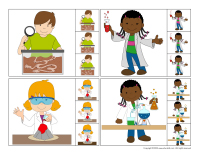
Pour water in a glass until it is half full. Sprinkle the water with a layer of pepper. Pour dishwashing liquid into a small container. Dip your finger into the soap, and then in the water. The pepper will run away from the soap!
Bubbles
Provide each child with a small glass of water. Add a few drops of dishwashing liquid in each glass. Give each child a drinking straw and a sheet of colorful construction paper. Children dip their straw in the glass and then blow on the construction paper to make a bubble. The bubble is gently deposited on the construction paper. Children will love observing it from every angle.
Fire
Have children sit in a circle. Place a candle in a candleholder. Deposit the candleholder in an aluminum plate in the center of the circle. Watch the candle closely. Notice how fire is beautiful. Discuss the dangers related to fire. When you are ready, gently place a glass jar (2-liter capacity) over the candle to snuff out the flame.
The potato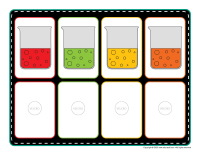
Cut a potato in two. Leave one half out on the counter and place the other half in water. Watch the changes throughout the week.
Follow the tracks
Take a walk outdoors, in the forest if possible. Try to identify the animals the tracks you see belong to.
Waltzing clouds
When you are outside, look closely at the clouds. Examine their shape and try to find clouds that look like various objects.
Archaeologist in the making
Dig a hole in the ground and search for insects or objects. Use a variety of tools to dig. Notice textures, colors, the temperature of the soil...
Dams
Outdoors or using a sand table, build canals and rivers. Then, block off certain areas by building a wall (with sand) or depositing objects in the canals and rivers. Ask children to watch what happens when you add water.
Rain
Set a transparent container outdoors on a rainy day. Then, bring it inside and observe the quantity, the color of the rainwater... Use a magnifying glass or microscope.
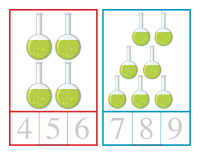
COGNITIVE ACTIVITIES
Counting cards – Science
(Open counting cards-Science) Print and laminate. Write or paint numbers 1 to 9 on a series of clothespins prior to this activity. Children must count the items in each rectangle and press the clothespin with the correct number on it on the corresponding number at the bottom of each card.
Color by number-Science
(Open colory by number-Science) Print for each child. Children must color the picture per the color code.
Coloring hunt and seek-Science
(Open coloring hunt and seek-Science) Print and laminate. Children must find and color the items at the bottom of the page.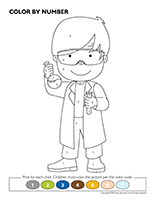
Numbered puzzles-Science
(Open numbered puzzles-Science) Print, laminate, and cut out the pieces. Children must arrange them in numerical order to complete the puzzles.
Educ-association-Science
(Open educ-association-Science) Print the game and press the pages in a file folder. Children must associate the cards. When they find an association, they simply set the card in the appropriate square using Velcro or adhesive putty.
I count-Science
(Open I count-Science) Print the document. Glue each number on a Styrofoam glass. Children must set the correct number of pompoms or cotton balls in each glass.
Count the drops
(Educ-math-Drops) Print and laminate for each child. Invite children to guess how many drops of water they must release to fill each circle. Using eyedroppers, they fill each circle with colorful water. Encourage them to count how many times they press the eyedropper to verify their hypotheses.
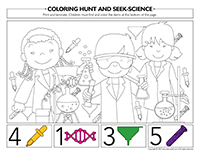
Water level
(Open water level) Print, laminate, and cut out the dripping water. Wrap 2 series of 10 tissue boxes with blue paper. Press a number from 1 to 10 on each box. Divide your group into 2 teams. Children attempt to stack the water in ascending or descending numerical order. If the boxes fall to the ground, they must start over. The first team that succeeds wins.
Educ-intruder-Science
(Open educ-intruder-Science) Print and laminate. Children must find the 6 intruders in the scene.
MORAL AND SOCIAL ACTIVITIES
Role play-Scientists
(Open role play-Scientists) Print and laminate the nametags and thread each one onto a ribbon or string so that children can wear them around their neck. Distribute the nametags among the children in your group to attribute various roles. Print and laminate the science-related labels too. Press them on the corresponding items using adhesive putty. Let children explore the theme through role-playing.
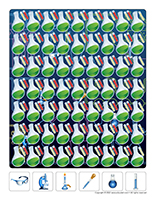
I am a scientist
In your role play area, install hooks that you can hang white shirts or white smocks on. Children will enjoy wearing them to dress up as scientists for various manipulations and activities throughout the theme. Set a thematic bin containing the following items nearby: magnifying glasses, safety glasses, rubber gloves, eyedroppers, measuring cups, beakers, funnels, seashells, rocks, magnets and paperclips, tweezers, mirrors, notebooks and pencils, dried leaves, buttons, empty bottles, flashlights, etc.
EARLY SCIENCE/MANIPULATION/EXPLORATION
Surprise germination eggs
Use hollowed eggs for this activity. Cut the top off of each egg and gently fill the eggshells with soil. Set the eggs in an empty egg carton. With your group, plant different types of flower seeds. Set the egg carton in a sunny location and water the eggs daily. With a little patience, flowers will start to grow!
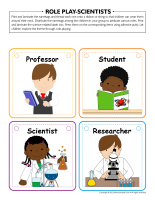
Our balls of grass
For this activity, you will need nylon stockings. Mix gardening soil and grass seeds. Fill the end of the stocking legs with this mixture to form 2 balls. Tie a knot above each stocking tip and cut off the excess fabric. Set each ball on top of a glass or pot. Regularly water the balls using a spray bottle and wait for the grass to grow. You can draw a face on each ball if you wish, just for fun.
My first herbarium
(Open my first herbarium) Print the pages for each child. Throughout the theme (or summer), encourage children to collect various types of leaves and flowers. They can press their findings on the pages of their herbarium. Write the date under each of their findings and help children identify them. Older children will enjoy having their own herbarium. With a younger group, you can print a single herbarium and work together to fill the pages.
Magnet game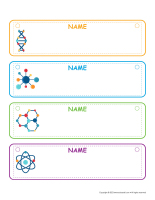
Set a variety of objects on a table (examples: nails, paperclips, coins, rubber bands, aluminum paper, Lego blocks, crayons, etc.). Set a magnet next to one item at a time to verify if they are attracted to it or not. Set the items that are attracted to the magnet in one bin and the items that are not attracted to it in a separate bin. Use this activity to explain how magnets are attracted to metals.
Rice bin
Fill a bin with rice and add figurines, measuring cups, containers, utensils, etc. Children will enjoy manipulating, measuring, and pouring as they pretend to be scientists.
Sensation box
Fill two or three boxes with various types of fabric. Cut holes that measure 2.5-3 centimeters in diameter out of each box. Encourage children to insert their hands through these holes to feel the fabric. Invite them to describe the different textures.
Moving grapes
Pour sparkling water in a glass and add a few grapes. After a few minutes, the grapes will start to move, like magic.
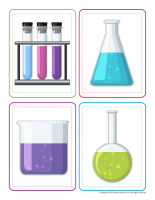
Colorful celery stalks
Add a few drops of food coloring, ideally blue or red, to a glass of water. Set a celery stalk with leaves in the glass. Set it aside for a few hours. You will slowly see the leaves change color and turn blue or red as the water travels up the stalk.
Three levels
Pour water into a glass until it is a little bit less than half full. Add honey. Observe the result: the honey remains in the bottom of the glass, even if you stir the water. Next, add oil. The oil will remain on the top, even after stirring the water. Children will be impressed to observe three different layers in the glass.
CULINARY ACTIVITIES
I can make bubbles
Add a drinking straw to children's milk glasses. Let them blow bubbles.
That smells good
Collect small film containers. Add Jell-O powder. Prepare several containers and punch holes in the lids. Invite children to guess the flavours that are in the containers.
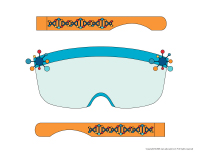
ARTS & CRAFTS
Science glasses
(Open science glasses) Print the model for each child. Invite them to cut out and color their glasses. Provide adhesive glitter that children can press on the sides of their glasses. They will enjoy wearing their glasses when they are pretending to be scientists or out and about in the neighborhood.
My science hat
(Open my science hat) Print and cut out. Glue the items all the way around a paper hat or headband.
Soap sculptures
You will need a bar of gentle soap for each child. Using a spoon, children can sculpt their soap to give it a fun shape. Press the shavings together to create an original bar of soap for your handwashing routine.
Color exploration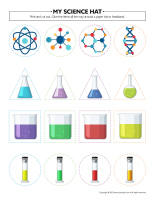
Add a small quantity of paint to a glass of water. Using a paintbrush, let a drop of color fall onto a piece of paper for each child. Encourage them to blow on the drop using a drinking straw to spread the color.
Colorful prints
A simple way to make finger paint is to pour liquid poster paint into a bowl, add a small quantity of flour, and mix until the texture resembles the texture of store-bought finger paint. Let children dip their fingers in the paint and make prints on paper.
Multicolored salt
Pour salt onto a sheet of paper. Add colourful crushed chalk to color the salt. Pour the salt into a container and repeat using a different colour. Use the salt for special collages. Simply apply glue to a piece of cardboard and pour salt over it. This is a great way to discover the magic of colors.
Feel the wind
Make pinwheels (Open craft-pinwheel) Print the model onto heavy paper and cut it out. Cut the paper from the outside corner to the center. Fold every other point towards the center. Use a fastener to hold everything in place. Add a drink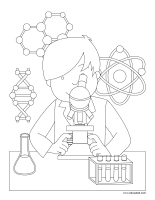 ing straw. Children will love blowing on it or running with it outdoors to make it spin.
ing straw. Children will love blowing on it or running with it outdoors to make it spin.
COLORING PAGES
(Open coloring pages theme-Science) Print for each child.
SONGS & RHYMES
I'm a little scientist
by: Patricia Morrison
sung to: I'm a little teapot
I'm a little scientist
Curious
Ask me a question
And I'll wonder
I will experiment
Get answers
After making hypotheses
SUGGESTION OF THE WEEK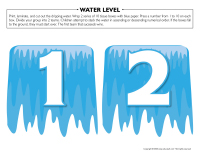
Angélique Boissonneault worked in a laboratory and was able to put her scientific knowledge into practice. She is a math, chemistry, and physics teacher but also developed a simple approach which involves renewed scientific experiments for young children. You may be familiar with some of these experiments, while others are not widely known. She presents Globule, your guide for her two passions: science and children.
Globule wonders...
Why do objects thrown in the air always come back down?
Experiment: Gravity
Hypotheses:
Ask children why everything we throw up into the air falls back down to the ground. Have them predict what will reach the ground first if we let a sheet of paper and a book fall to the ground at the same time. If we crumple up the piece of paper, will the result be the same? Ask them why all objects fall to the ground instead of floating in the air.
Material:
- A chair
- A book which can be held in one hand by a child
- 2 sheets of paper the same size as the book or a little smaller
- Other objects of different weight (pebble, ball, pencil, etc.)
Manipulations:
- The daycare worker chooses a child to stand on the chair.
- The other children sit on the floor, not too close to the chair.
- The child on the chair holds the first two objects (book and smooth sheet of paper) in front of him horizontally and at the same level.
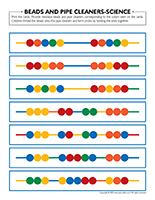
- When the daycare worker gives the signal, the child lets go of both objects at the same time.
- Watch how the sheet of paper gently dances in the air as it goes down. As children probably predicted, the book hits the ground first.
- Another child stands on the chair and repeats the experiment with the same book. This time however, he holds a crumpled piece of paper in the other hand. Is the result different?
- Finally, another child climbs onto the chair. He places the smooth sheet of paper on the book and drops them. What happens?
- Try a variety of different objects.
Explanations:
At first, you probably thought the book would touch the ground first since it is heavier.
However, once the piece of paper was crumpled, they hit the ground at the same time! Funny, since it is the same piece of paper and the book is still heavier. It all comes down to form.
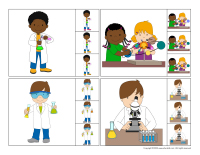
When the paper is smooth, it exposes a large surface to the air beneath it which slows its descent. Once it is crumpled, the surface which comes in contact with the air is much smaller, allowing it to fall much faster.
When the sheet of paper is placed on the book, there is no air at all beneath it. For this reason, the two objects fall at the same speed. This force is called gravity. It attracts objects to the ground like a magnet.
All objects are attracted to the ground by the same force, gravity. They all fall at the same speed unless air offers a resistance strong enough to slow them down.
For more experiments with Globule,
visit http://www.educatall.com/Science-corner.html
Have fun!
The Educatall team
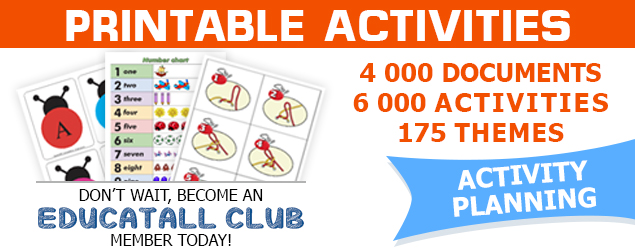
 Home
Home Theme activities
Theme activities
 Babies and toddlers
Babies and toddlers
 Arts and crafts
Arts and crafts
 Science
Science
 Creative recipes
Creative recipes
 Tips and tricks
Tips and tricks
 Special needs
Special needs
 Extra activities
Extra activities
 Educ-TV
Educ-TV
 Newsletter
Newsletter  Online store
Online store Educatall club
Educatall club

